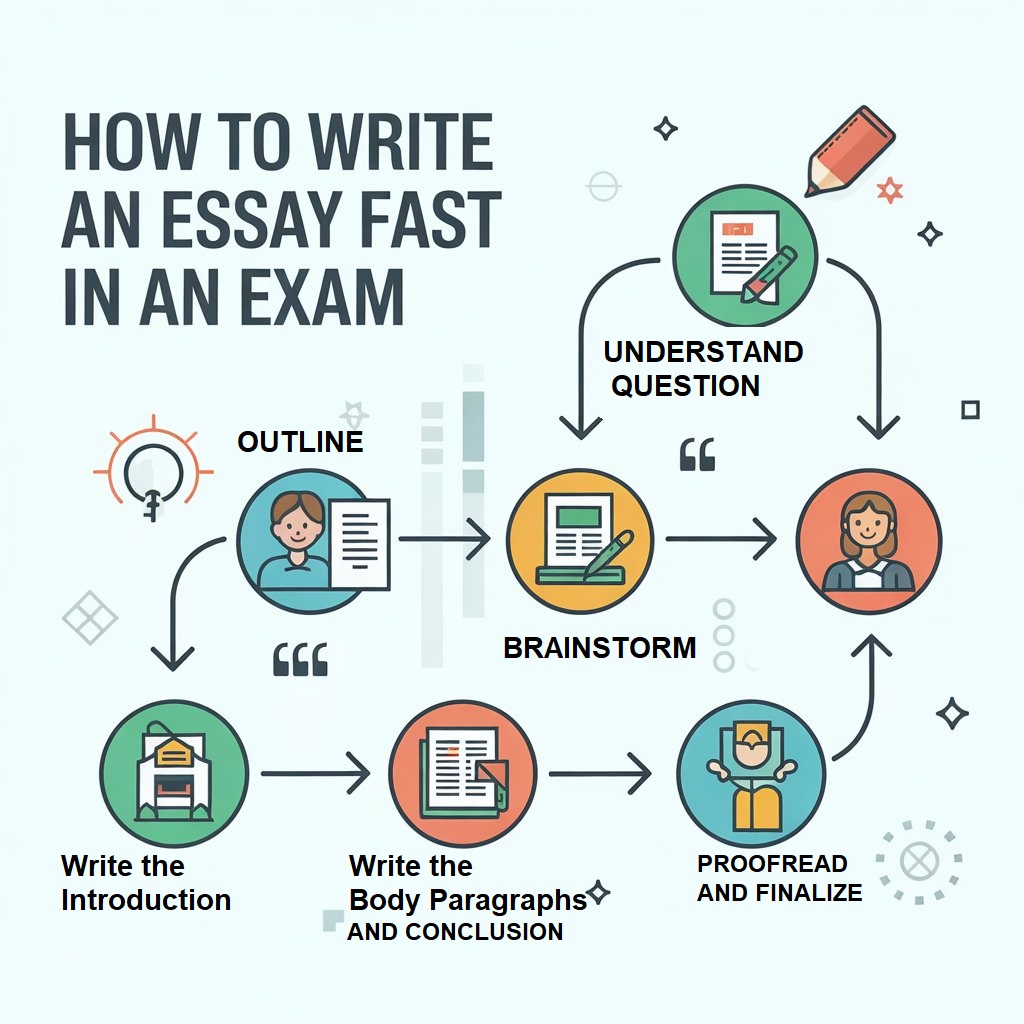If you want to write an essay, it can be challenging, especially if the deadline is too short, you need to submit it, and you are under pressure. Whether you’re facing a tight deadline or want to streamline your writing process, understanding the art of Custom essay writing quickly requires a combination of planning, focus, and efficiency.
From organizing your thoughts to staying on topic and minimizing distractions, there are key strategies that can help you write a quality essay in less time. Let’s look at the steps to speed up your writing process without omitting clarity.
Writing a strong essay under time pressure is a skill that can be developed through practice and preparation. Whether you are writing during a 40-minute classroom test or a 60-minute standardized exam, this guide will walk you through a clear, proven strategy to organize your ideas, write efficiently, and communicate your argument with clarity.

Suggested Time Allocation (for a 40-Minute Essay)
Step 1: Understand the Question (2–3 Minutes)
Begin by carefully reading the prompt. Many students lose marks by misinterpreting or failing to address the question fully.
Key Actions
-
Identify the directive verb: Analyze, discuss, evaluate, argue, compare, and describe.
-
Determine the topic and focus: What is the subject, and what specific aspect are you being asked to address?
-
Note any scope or limitations: If the question specifies “in modern society” or “since 2000,” ensure your response stays within that boundary.
Example Prompt:
“Evaluate the role of technology in modern education.”
Interpretation: You are expected to weigh the benefits and drawbacks of technology in education and then present a balanced judgment.
Step 2: Brainstorm and Outline (5–7 Minutes)
Even during timed exams, a brief plan can save valuable minutes later and significantly improve the coherence of your essay.
Brainstorming
-
Write down 3–4 points that are relevant to the topic.
-
Consider including both supporting and opposing arguments if appropriate.
-
To support each point, consider examples or evidence, such as studies, historical events, statistics, or real-world observations.
Basic Essay Outline
Introduction
Body Paragraph 1
-
Main idea
-
Supporting evidence or example
-
Explanation of its relevance
-
Transition to the next paragraph
Body Paragraph 2
Optional Body Paragraph 3
Conclusion
Step 3: Write the Introduction (5 Minutes)
The introduction sets the stage and introduces your argument. It should be brief but effective.
Structure
-
Hook: Use a question, fact, or general observation.
Example: “Over the past decade, digital tools have revolutionized how students learn and interact with educational material.”
-
Context: Provide 1–2 sentences outlining the background of the issue.
-
Thesis Statement: Clearly state your position or central argument.
Example: “Although technology enhances access and flexibility in education, it also presents challenges such as distraction and digital dependence.”
Step 4: Write the Body Paragraphs (15–20 Minutes)
The essay’s body is where you develop your points using evidence and explanation. Each paragraph should focus on one main idea.
Use the PEEL Method:
-
Point: Present the central idea of the paragraph.
-
Evidence: Support the point with a specific example, fact, or data.
-
Explanation: Explain how the evidence supports the point and relates to the thesis.
-
Link: Connect the paragraph to the next or back to the thesis.
Sample Body Paragraph 1:
Point: Technology improves access to quality education.
Evidence: According to a UNESCO report, online platforms reduced dropout rates by 25% in rural regions.
Explanation: This demonstrates how educational technologies can bridge gaps in access, especially in underserved communities.
Link: As such, technology plays a key role in educational equality.
Sample Body Paragraph 2:
Point: However, excessive reliance on technology can hinder learning.
Evidence: A study by the American Psychological Association found that students who multitask with digital devices during lessons score 20% lower on retention tests.
Explanation: This shows that digital tools, while beneficial, can also serve as major distractions.
Link: It is important to acknowledge the limitations of digital learning environments.
Sample Body Paragraph 3 (Optional):
Point: A balanced approach that combines technology with traditional instruction may offer the best results.
Evidence: Many institutions use blended learning models like flipped classrooms to promote interaction alongside independent learning.
Explanation: This hybrid model supports student engagement and accommodates different learning styles.
Link: Therefore, integrating technology with face-to-face teaching is the most effective solution.
Step 5: Write the Conclusion (5 Minutes)
A strong conclusion reinforces your argument and provides closure without introducing new ideas.
Structure
-
Restate the thesis in new words.
Example: “Technology is reshaping education, but its effectiveness depends on how it is implemented.”
-
Summarize the main points discussed in the body.
-
Final insight: Offer a thought-provoking observation or practical recommendation.
Example: “As classrooms continue to evolve, educators must find a balance that combines digital innovation with personal interaction.”
Step 6: Proofread and Edit (2–3 Minutes)
Use the last few minutes to make small but meaningful corrections. These can improve clarity, grammar, and overall polish.
What to Check
-
Grammatical errors and spelling mistakes
-
Sentence clarity and variety
-
Logical flow between paragraphs
-
Consistent verb tenses and point of view
-
Thesis alignment: Make sure all points support your central argument
Final Essay Structure
INTRODUCTION:
– Hook
– Background
– Thesis
BODY PARAGRAPH 1:
– Point
– Evidence
– Explanation
– Link
BODY PARAGRAPH 2:
– Point
– Evidence
– Explanation
– Link
(OPTIONAL) BODY PARAGRAPH 3:
– Point
– Evidence
– Explanation
– Link
CONCLUSION:
– Restated Thesis
– Summary of Points
– Final Insight
Conclusion
Success in exam essay writing does not require perfection; it requires clarity, structure, and time management. Following this systematic approach, students can write high-scoring essays even under tight time limits. Regular practice using these steps can significantly boost confidence and performance on exam day.









 Evan John
Evan John